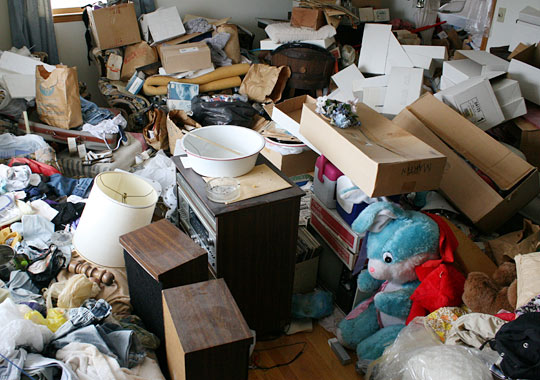The reality show Hoarders, now in its sixth season, opens with the following words on screen: “Compulsive hoarding is a mental disorder marked by an obsessive need to acquire and keep things, even if the items are worthless, hazardous, and insanitary.” We are then informed that more than 3 million people are compulsive hoarders.
Each episode of Hoarders focuses on the extreme decluttering and cleanup process of two homes, spearheaded by therapists and professional extreme cleaning teams. Over the course of the episode, we learn about the background of the hoarders, experience their interactions with family and friends, and typically witness intense manifestations of resistance to the decluttering process. Toward the end of most episodes, after at least partial success in cleaning, the team brings in a decorator who alters the appearance of the former hoard, and the hoarder expresses their pleasure at the result. The show follows up with therapeutic aftercare with the participating hoarders.
The show is famous for the shock value of the “before” interiors, many of which are cluttered and filthy to the point of being uninhabitable. And, indeed, the dangers involved in the situation are very real: health and fire hazards, not to mention animal cruelty and risks to the adults and children navigating stuffed rooms and hallways. The professionals and family members point out these risks to the hoarders, frequently citing the law; the need to clean usually is in response to an external legal emergency, such as the condemnation of a house or an intervention by child protective services. But often, the consequences threatened are not immediate and physical (“you’ll get sick,” “you’ll catch fire”), but rather, they are emotional and regulatory responses to a socially unacceptable lifestyle.
The show consistently communicates the message that its subjects are empowered to take care of their mess and get their lives “unstuck.” But as depicted, the cleanup process is actually a process of relinquishing control over one’s home and placing oneself in the shameful and vulnerable position of being judged by others. These “others” are consistently introduced in short autobiographies as “specialists” or “experts” in hoarding, OCD, and organization. When family members enter the picture, they berate the hoarders for not submitting to the experts’ judgment. The last in the series of such experts are decorators who redo people’s homes. Notably, only the middle-class (or formerly middle-class), educated hoarders dare to challenge this authority, by suggesting that the decorators’ choices may not be to their personal taste. These are also the folks who try to argue against the law’s authority to take over their lives: “It’s not true that you need to call Child Protective Services on me.” “I can negotiate the fines with the county.” “I don’t think this is a fire hazard.” The poorer protagonists either submit fully to the commands of the experts, lectured at but not listened to, or experience fits of explosive rage out of powerlessness.
The subjectivity of judgment is most stark when the boundary between hoarding and collecting is problematized. The show’s therapists attempt to explain to inventors, vintage doll collectors, and pinball-machine enthusiasts that their passion is pathological. Their parameters for pathology – amount, enthusiasm, “no rhyme or reason” to the collection – can easily be questioned. The power they wield over their subjects stems from their ownership of the pathology definition and from the legitimacy they get from the hoarders’ family members and friends who support their opinion about the disorder.
But even in cases in which consensus for the diagnosis is easier to reach, there is a bigger social context at work. While much of the situation is objectively problematic, some of the compulsive behavior is only visible because of the class and economic situation of the homeowner. No one accuses rich movie stars, owners of multiple planes, homes, and countless clothes, accessories, and expensive trinkets, of being hoarders, because their accumulation of material items is socially acceptable and their living quarters can accommodate the abundance. In some ways, it may be that hoarding is a disease of capitalism, brought about by the constant pressure to consume and accumulate items, and its pathologization — as is the case for numerous categories of deviance — targets the “have-nots.” Warren Buffett’s oft-quoted maxim, according to which “if you don’t buy things you do not need, soon you will have to sell things you need” comes from a person who has the economic security to know that, should he need something, he will be able to buy it. Some of the hoarding behavior examined on the show is the outcome of personal trauma, where the items create a feeling of safety; socially, it feels like a security blanket against the insecurities of a minimalist state and compliance with the message that we should take care of our own needs.
Finally, I find it important that many of the hoarded items were mass-produced and purchased for little value. In a culture in which, rather than fixing and cleaning one’s existing possessions, the easier available solution is to buy new, cheap, made-in-China replacements, we are allowing the abysmal working conditions elsewhere in the world enable our collective and individual pathologies around nothing more than stuff.









